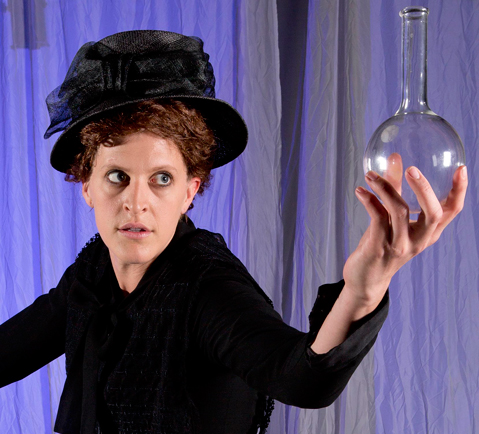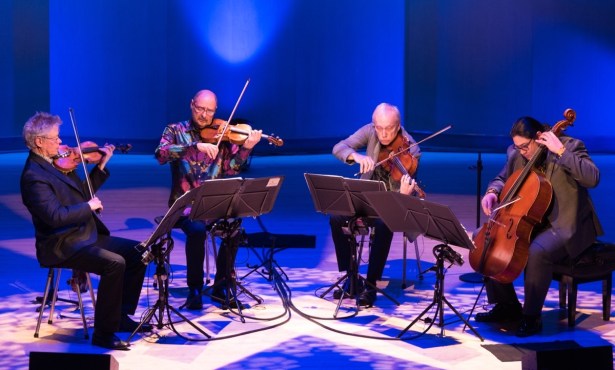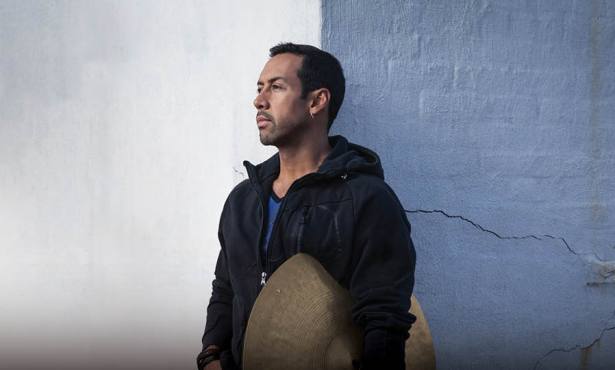Piezoelectric Love at UCSB
The Half-Life of Marie Curie Gets a Variety-Show Treatment

As a maker of theater, Jeff Mills doesn’t much go for the tried-and-true traditional approach. Mills is a trained actor, an accomplished mime, and an expert in stage combat, but when it comes to organizing material for other people, he’s all about the unexpected. Beginning on Friday, May 11, and running through May 19, what may be Mills’s most audacious project yet, a theatrical biography of the great scientist Marie Curie, will show at UCSB’s Performing Arts Theatre. Called Piezoelectric Love: The (half) Life of Marie Curie, the production is, as described by Mills, “a mask play, a clown piece, a dance concert, a Chekhovian-style drama, and a docu-play all in one.”
Fittingly, the show’s rather mystifying title derives from science. Piezoelectricity is the electrical charge generated when certain types of crystals undergo stress, and in addition to being the subject of Pierre Curie’s early research, it’s also, according to Mills, an apt metaphor for the life of Marie, who was exalted by science at the same time that she was pressured and even deformed by the complexity and turbulence of her emotional life. The play, which was created in part as a response to the recent spate of revisionist scholarly biographies of Marie Curie, seeks to put her experience in the context of the unfolding evidence about the lives of female scientists in the early 20th century, a time when very few women entered the field, and even fewer — in fact virtually none — went on to such acclaim as Curie, who earned Nobel Prizes in two different fields.
Mills has brought in several savvy collaborators for Piezoelectric Love, each of whom promises to impart something exciting and different to the final product. Valerie Slitor, a UCSB graduate student in theater, has been helping with the writing and research. She feels that the project has significant feminist implications, and she derives some of what she is doing with the material from her recent critical work on Caryl Churchill. This works well with what the cast has been up to; many of the performers, including Allie Granat and Brian Bock, were in the excellent UCSB production of Churchill’s Cloud Nine last winter. Also involved are the music and songwriting team of James Connolly and Anna Abbey, the duo responsible for the brilliant pop-rock score for Lit Moon Theater’s The Wedding.
The show’s subtitle refers in two directions — toward the half-life of a radioactive element and toward the half of Marie Curie’s life that was hidden from public view. “Marie Curie had a tremendous magnetism,” Mills told me, “and many of the men in her life wanted her.” As for the way in which this half life will be presented, that’s where things get a little, well, funky. “As a child, I was fascinated by television variety programs” said Mills, “Sonny & Cher, Andy Williams, The Smothers Brothers, Laugh-In. And what I wanted to see is what would happen if we used that particular medium to present this story.” As a result, Marie Curie will do some unexpected things over the course of an evening that is sure to include more than its fair share of surprises. Mills went on to elaborate, saying that “it’s important to make the connection between Marie Curie and the nuclear era, because that’s where the story becomes most interesting and relevant to today. She got out of Poland in 1887 and made her way to Paris, where she became part of the scientific community at a time when it was still dominated by a Newtonian, clockwork-type vision of the universe. But then, through her discovery of polonium and her work with radiation, she became one of the first people to consider what the physical world would look like after gaining knowledge of the atom. At the same time, she was coming into her own as a public figure, and this was something that she was ambivalent about.” When asked what this has to do with the television variety shows of the 1970s, Mills offers a broad smile before responding enthusiastically. “We’re aiming for an ugly kind of truth, and the way we’re getting there is by abandoning the television movie-of-the-week as a model for understanding a life and moving instead to something that, on the surface at least, is totally different,” he explained. “By filtering this material through a different set of generic conventions, we’re arriving at a different view of her experience. The variety show and the layers of music and masks and clowning are there to allow us access to the half-life that is ordinarily hidden from view.”
The story of Piezoelectric Love would not be complete without some sense of where it fits into the program at UCSB, and Mills speaks eloquently to the question, connecting his own training there with the experience he offers to his students now that he has joined the faculty. “I took James Donlon’s mime class my freshman year, and I never looked back. Donlon was a champion of simplicity and economy, yet he showed how the work should also be open to madness. He showed me what kinds of ideas can come when you cross the threshold.” And what threshold is that? Come out to the UCSB Performing Arts Theatre, and cross it yourself to see.
4•1•1
Piezoelectric Love: The (half) Life of Marie Curie will be at UCSB’s Performing Arts Theatre from Friday, May 11, through Saturday, May 19. For tickets and information, call 893-3022 or visit theaterdance.ucsb.edu.



